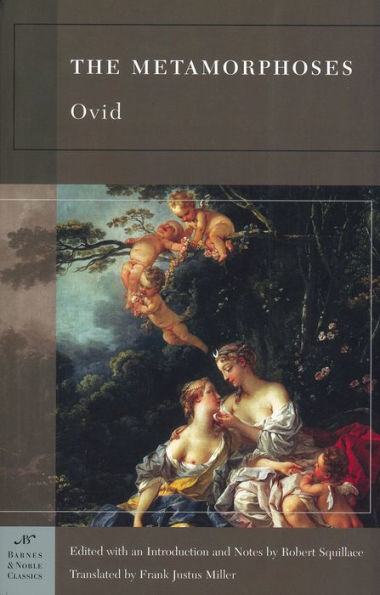- New introductions commissioned from todays top writers and scholars
- Biographies of the authors
- Chronologies of contemporary historical, biographical, and cultural events
- Footnotes and endnotes
- Selective discussions of imitations, parodies, poems, books, plays, paintings, operas, statuary, and films inspired by the work
- Comments by other famous authors
- Study questions to challenge the readers viewpoints and expectations
- Bibliographies for further reading
- Indices & Glossaries, when appropriate
First published in 8 A.D., Ovid’s Metamorphoses remains one of the most accessible and attractive avenues to the riches of Greek mythology. Beginning with the creation of the universe and ending with the death and deification of Julius Caesar, Ovid’s masterful epic poem features a rich assortment of tales, including those of Jason and the Argonauts, Orpheus and Eurydice, the Trojan War, Echo and Narcissus, the slaying of the Minotaur, Daedalus and Icarus, Hercules, Aeneas and Dido, the wedding of Perseus and Andromeda, and many others. These stories all have one element in common: transformation. Mortals become gods, animals turn to stone, and humans change into flowers, trees, or stars. Mingling pathos, humor, beauty, and cruelty, Ovid reveals how the endless ebb and flow of the universe itself is mirrored in the often paradoxical and always arbitrary fate of the poem’s characters, both human and divine.
A cosmic comedy of manners, Metamorphoses was read with delight in Ovid’s own time and continues to charm audiences today, providing a treasure trove of myth and legend from which the whole of Western art and literature has derived incalculable inspiration.
Robert Squillaceteaches Cultural Foundations courses in the General Studies Program of New York University. He has published extensively on the field of modern British literature, most notably in his study Modernism, Modernity and Arnold Bennett (Bucknell University Press, 1997). His recent teaching has involved him deeply in the world of the ancients. He lives in Brooklyn with his wife, the medievalist Angela Jane Weisl. Squillace also wrote the Introduction and Notes for the Barnes & Noble Classics edition of Homer’s Odyssey.
- New introductions commissioned from todays top writers and scholars
- Biographies of the authors
- Chronologies of contemporary historical, biographical, and cultural events
- Footnotes and endnotes
- Selective discussions of imitations, parodies, poems, books, plays, paintings, operas, statuary, and films inspired by the work
- Comments by other famous authors
- Study questions to challenge the readers viewpoints and expectations
- Bibliographies for further reading
- Indices & Glossaries, when appropriate
First published in 8 A.D., Ovid’s Metamorphoses remains one of the most accessible and attractive avenues to the riches of Greek mythology. Beginning with the creation of the universe and ending with the death and deification of Julius Caesar, Ovid’s masterful epic poem features a rich assortment of tales, including those of Jason and the Argonauts, Orpheus and Eurydice, the Trojan War, Echo and Narcissus, the slaying of the Minotaur, Daedalus and Icarus, Hercules, Aeneas and Dido, the wedding of Perseus and Andromeda, and many others. These stories all have one element in common: transformation. Mortals become gods, animals turn to stone, and humans change into flowers, trees, or stars. Mingling pathos, humor, beauty, and cruelty, Ovid reveals how the endless ebb and flow of the universe itself is mirrored in the often paradoxical and always arbitrary fate of the poem’s characters, both human and divine.
A cosmic comedy of manners, Metamorphoses was read with delight in Ovid’s own time and continues to charm audiences today, providing a treasure trove of myth and legend from which the whole of Western art and literature has derived incalculable inspiration.
Robert Squillaceteaches Cultural Foundations courses in the General Studies Program of New York University. He has published extensively on the field of modern British literature, most notably in his study Modernism, Modernity and Arnold Bennett (Bucknell University Press, 1997). His recent teaching has involved him deeply in the world of the ancients. He lives in Brooklyn with his wife, the medievalist Angela Jane Weisl. Squillace also wrote the Introduction and Notes for the Barnes & Noble Classics edition of Homer’s Odyssey.

The Metamorphoses (Barnes & Noble Classics Series)
416
The Metamorphoses (Barnes & Noble Classics Series)
416eBook
Related collections and offers


Product Details
| ISBN-13: | 9781411432673 |
|---|---|
| Publisher: | Barnes & Noble |
| Publication date: | 06/01/2009 |
| Series: | Oz Series |
| Sold by: | Barnes & Noble |
| Format: | eBook |
| Pages: | 416 |
| Sales rank: | 335,564 |
| Lexile: | NP (what's this?) |
| File size: | 6 MB |
| Age Range: | 3 Months to 18 Years |
